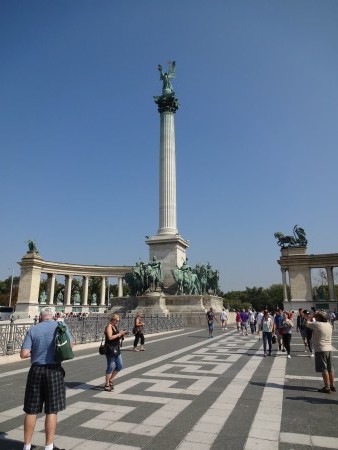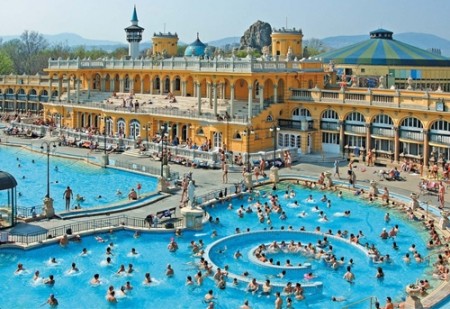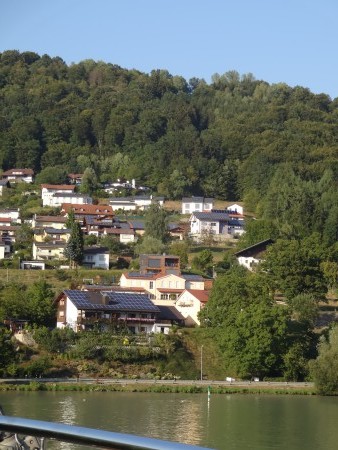September 8, 2015 – We started in the Czech Republic, then Germany, Austria and Hungary. Because we did more highway than river we got to see not just urban centres but the countryside. And we also got to hear local guides describe their perspectives on their own countries, not just the sites, but opinions and feelings from a historic and contemporary perspective. None talked about the future. Nor did I expect them to without prompting – which of course I did.
What this journey across Central Europe revealed is a strong faith-centrist focus. As a graduate of Islamic Studies and Medieval History this to me was no surprise. It seems to tour Central Europe you must see churches and more churches, palaces and big phallic war and victory monuments (see this one in Budapest which reminds me of a similar one we once saw in Revolution Square in Havana, Cuba).
The guides seemed quite capable of talking about architectural styles from Romanesque, Gothic, Baroque, and Rococo, to Neoclassicism. But pinning them down to talk about where their countries were heading was an interesting challenge.
One young man, a PhD student in Economics described the future of Bavaria as one of diminishing returns. Two Hungarian guides talked about their loss of economic viability from the collapse of Austria-Hungary in 1918. The sense of pessimism about where Central Europe was heading was somewhat disturbing. And the headlines perpetuated the pessimism because in the same week as we were stranded in the middle of the Danube refugees from Syria and Iraq were pressing Hungary’s borders to get through to Austria and Germany where they could seek asylum. Hungary’s answer….hostility and then a quick surrender moving the masses to the West and on and out of the country.
In being an eye witness to all this I started thinking about adaptation strategies and how nations have to develop new paradigms operating outside their traditional comfort zones if they are going to make it to the year 2100 in decent shape.
For example, in Hungary were the past seems more glorious than the present the Magyar people have their task cut out for them. The country sits in a geothermal hot spot with estimated heat energy capacity of 604,000 petaJoules. Today about 100 geothermal facilities are being used for baths, swimming pools and greenhouses. But Hungary could become a rival to Iceland and New Zealand in the field of clean geothermal energy meeting domestic requirements and even export potential. Instead the Hungarians are wallowing around in hot water baths and talking about 1918. Current forecasts for 2020, a mere 5 Megawatts from geothermal.
Hungary is also largely dominated by flat-lands with good wind energy potential. I saw evidence of wind farms on the two-hour bus rides to and from Budapest. But Hungary has done little to expand past the 329 Megawatts of installed wind power it has had since 2013. The country originally forecasted 552 Megawatts in that year and 740 Megawatts by 2020, but it just seems lethargy and uncertain politics dog the country as it tries to make the transition to a renewable energy future.
Hungary’s greatest asset is its people. Literacy rates approach 100%. Mobile phone and Internet use is very high. Post-secondary enrollment approaches 60%. An educated workforce could be the key to the country’s ability to adapt as the century continues to unfold.
In Bavarian Germany the evidence of the country’s progression towards a low-carbon economy was clearly evident. Solar panels were on 50% of the homes in the villages we past. Even as we sailed through Austria’s Wachau Valley we could see the transformation to renewable energy sources in numerous small villages and farms. But our Bavarian bus tour guide lamented that competition from China was putting German solar panel makers out of work. What he failed to see was the potential that solar installed capacity represented as a disruptive force for change leading to microgrids and distributed energy solutions with significant job potential.
So here are seven adaptation strategies for countries seeking a good outcome for 2100.
- Don’t live in the past. Old systems and old ways of thinking and doing things will no longer work in today’s and tomorrow’s world. Hungary cannot climb to greatness re-fighting World War One. Germany cannot re-fight World War Two. Germany has learned that but it seems Hungary may have not.
- Nations need to learn to adjust to rapidly changing circumstances in a shrinking world. Look at the migration crisis engulfing Central Europe as a result of protracted civil wars in the Middle East. Embracing the change rather than fighting it could yield significant bonuses. Remember in Europe the population of countries is contracting and aging. Refugees could turn into tomorrow’s workforce and taxpayers given suitable education and opportunity. Cultural diversity should not be feared. Through it innovation often happens.
- Embrace the low-carbon future sooner than later. By 2050 any nation not doing this will be left behind in the dust. Nations that adopt low-carbon goals will make the great leap reaping the benefits, the knowledge and the skills derived from mastering clean renewables, carbon sequestration, and conservation technologies, all very exportable.
- Invest in infrastructure. For the countries of the Danube River basin who are facing increasing cycles of extreme weather, floods one year, drought the next, flood abatement technology similar to that built by Vienna could mitigate damage dramatically.
- Look at the sciences of genomics and genetic engineering to address future food security. There is no justification to allow popular fears to eliminate this important and disruptive science that has such enormous potential.
- Create a dynamic education environment encouraging all citizens to participate in continuous lifelong learning to create infinite flexibility in the workforce. For every job a robot may take from a human there will be new jobs created to build, code and maintain robots.
- Keep an open mind. That goes for individuals and nations. That means continuous experimentation, creating means to encourage innovation. We have Internet tools in place today that encourage solutions from the crowd. Entrepreneurs compete for prize money often in the millions of dollars. Whole new industries are being created this way.












